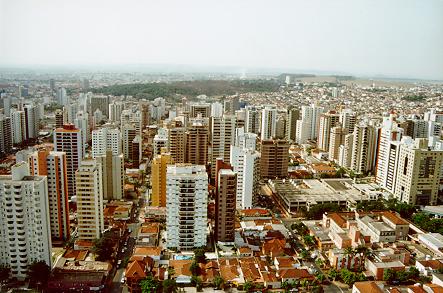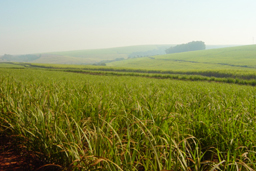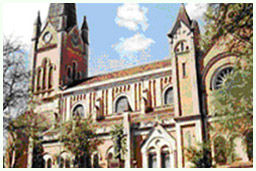| |
|
| |
RIBEIRÃO PRETO

RIBEIRÃO PRETO (Black Stream)
is the hub of the fastest developing region
in Brazil. Established in 1856, within a clearing
through which a century earlier the early explorers
(Bandeirantes) had traveled, the city boomed
on coffee growing, farmed by immigrants and
fertilized by red earth known as “rossa”
by Italians and “roxa” in the indigenous
“caboclo” language.
At the turn of the XIX century the fertile lands
around Ribeirão Preto made the region
the largest producer of coffee and a world supplier
for what was called “green gold”.
Thus the former clearing, fed by two streams,
soon became an important city linked to the
rest of Brazil by rail, telephone and highways.
Development brought new crops, such as sugarcane,
soy, maize, cotton, and oranges, and led to
the establishment of a strong agricultural industry.
Ribeirão Preto is known as the Brazilian
capital of agribusiness.
The region of Ribeirão Preto is made
up of more than 80 counties that are home to
3 million inhabitants and cover an area of 30
thousand km2. Per capita income approaches that
of some European Mediterranean countries and
is almost double the national average.
The Ribeirão Preto Medical School of
the University of São Paulo is an integral
part of the regional health network. Biomedical
research conducted by the Medical School is
a reference in the country and accounts for
4% of Brazil’s academic output and is
recognized internationally.
|
THE
CAMPUS OF THE UNIVERSITY OF SÃO PAULO

|
| |
THE
CAMPUS OF THE UNIVERSITY OF SÃO PAULO.
Ribeirão Preto is home to the
second largest of the University of São
Paulo’s eight campi. It is situated within
the area of the former Monte Alegre Farm, comprising
colleges of Medicine, Dentistry, Pharmacy, Nursing,
Economics, Administration, Accounting, Biology,
Psychology, Law, Chemistry and Medicine, and research
produced there is internationally recognized.
The Campus also houses the General Hospital, one
of the most advanced research centers in Latin
America, and a Bloodbank, residences for teachers,
student accommodations, banks, athletic facilities,
restaurants, a post office and publishers. It
boasts an arboretum and a beautiful park and,
lake. It also houses preserved buildings of the
Italian immigrant colony from the beginning of
last century which was originally part of the
Monte Alegre Farm.
|
ECONOMY

|
A SUGAR AND ALCOHOL VCENTER
Thanks to the geographic characteristics of the
land, weather and quality of the soil, Ribeirão
Preto is the center of a region that is the biggest
food producer in São Paulo State. It is
the state’s, and in some cases, the country’s
top producer of soy beans, corn, rice, coffee
and cotton. Thirty-five percent of São
Paulo State’s grain production take place
in the city’s region. However, it is the
sugar cane that places Ribeirão Preto and
it region as the major producer and exporter of
sugar and alcohol in the world.
Agribusiness is one of the driving forces of the
economy of Ribeirão Preto and is region,
to such and estent that it was awarded the title
of “the capital of agribusiness”.
Agriculture
makes of the region one of the most important
and prosperous farming areas of the State. Special
emphasis given to sugar cane, oranges, soybean,
coffee, peanuts, and fruits in general. The region
is one of the main players in the production of
sugar and alcohol, with 21 sugar mills that employ
aroubd 8 thousand individuals. One the other hand,
the industrial sector of Ribeirão Preto
is noted for its productive diversification. The
industrial cluster concentrates over 1,200 companies
and main sectors boost up the economy of the region
are: production of food and beverages, healthcare
industries, paper, cardboard and printing, metalworks,
textile and garment industries
|
THE
PEDRO II THEATER |
| |
|
|
Ribeirão Preto experienced its
first economic heyday in the 1920s. Its status
as largest coffee producer gave the city an air
of Eldorado. At this time, in 1928, João
Meira Júnior, the President of the Paulista
Brewery Company, began construction of a grand
opera theater. The project was inspired by European
show houses.
The New York stock market crash in 1929 and the
ensuing world economic crisis impacted the building
of the theater. Several standards of finish underwent
change. Nevertheless, the theater emerged as a
symbol of the power of the coffee society and
was inaugurated on October 8th, 1930.
|
PINGÜIM
 |
|
The
“Pingüim”, inaugurated on November
10th 1943, is one of the “visiting cards“
of Ribeirão Preto, because it serves the
most famous chopp (draft beer) in Brazil. The
traditional choperia (draft beer pub) was founded
by Nicolás Miranda and is located in the
Edificio Diederichesen, also part of the Quarteirão
Paulista, where the Snooker Pinguim was located
at the very beginning.
Every day, around 2 thousand people drink over
2 thousand liters of draft beer, served in crystal
tulip glasses. The beer goes through an 800-meter-long
streamer before getting to the dispenser.
|
|
PARQUE PREFEITO LUIZ ROBERTO JÁBALI
|
|
|
|
| Is
an environmental and recreational complex containing
152 thousand square meters of vegetation and the
city’s largest recreational space. The project,
devised by municipal authorities, transformed
an early mining area for basalt rock. This rock
was formed by volcanic eruptions some 130 to 60
million years ago. The complex is an ideal area
for excursions and rambling. Waterfalls and artificial
lakes were built near a square for events and
beautify and refresh this environment.
|
SÃO
SEBASTIÃO METROPOLITAN CATHEDRAL

|
|
The footstone was settled on march 3rd 1904 and
the construction was finisched in 1920. The style
is Romenesque with gothic lines the stained glasses
and frescos by Benedito Calixto from 1917 deserve
a special mention
|
|
MUSEU
CASA DE PORTINARI
|
|
|
|
Inaugurated in 1970, the museum displays works
of artist Cândido Portinari. Also Furniture
and utensils of the familiy. The museum exhibits
drawings, desings and poems by the artist, as
well as the murals of the house.
|
MUNICIPAL
THEATER
 |
Inaugurated in 1969, the Municipal Theater features
thrree modem lines and has a seating capacity
for 515 peaple. Because it is na wide venue,
with many trees, it is very often used also
for cutural events.
|
|

